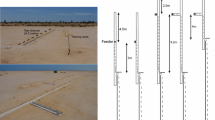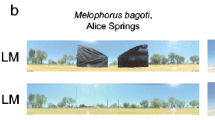Abstract
Desert ants, Cataglyphis fortis, associate nestward-directed vector memories (local vectors) with the sight of landmarks along a familiar route. This view-based navigational strategy works in parallel to the self-centred path integration system. In the present study we ask at what temporal stage during a foraging journey does the ant acquire nestward-directed local vector information from feeder-associated landmarks: during its outbound run to a feeding site or during its homebound run to the nest. Tests performed after two reversed-image training paradigms revealed that the ants associated such vectors exclusively with landmarks present during their homebound runs.





Similar content being viewed by others
References
Batschelet E (1981) Circular statistics in biology. Academic Press, New York
Bisch S, Wehner R (1999) Context-dependent retrieval of local vectors in desert ant navigation. Proc Neurobiol Soc Göttingen 27:429
Bisch-Knaden S, Wehner R (2001) Egocentric information helps desert ants to navigate around familiar obstacles. J Exp Biol 204:4177–4184
Collett M, Collett TS, Bisch S, Wehner R (1998) Local and global vectors in desert ant navigation. Nature 394:269–272
Collett M, Collett TS, Wehner R (1999) Calibration of vector navigation in desert ants. Curr Biol 9:1031–1034
Dyer FC, Gill M, Sharbowski J (2002) Motivation and vector navigation in honey bees. Naturwissenschaften 89:262–264
Grossmann KE (1970) Erlernen von Farbreizen an der Futterquelle durch Honigbienen während des Anflugs und während des Saugens. Z Tierpsychol 27:553–562
Heusser D, Wehner R (2002) The visual centring response in desert ants, Cataglyphis fortis. J Exp Biol 205:585–590
Lehrer M (1993) Why do bees turn back and look? J Comp Physiol A 172:544–563
Lehrer M, Collett TS (1994) Approaching and departing bees learn different cues to the distance of a landmark. J Comp Physiol A 175:171–177
Menzel R (1968) Das Gedächtnis der Honigbienen für Spektralfarben. I. Kurzzeitiges und langzeitiges Behalten. Z Vergl Physiol 60:82–102
Menzel R, Geiger K, Joerges J, Müller U, Chittka L (1998) Bees travel novel homeward routes by integrating separately acquired vector memories. Anim Behav 55:139–152
Müller M, Wehner R (1988) Path integration in desert ants, Cataglyphis fortis. Proc Natl Acad Sci USA 85:5287–5290
Müller M, Wehner R (1994) The hidden spiral: systematic search and path integration in desert ants, Cataglyphis fortis. J Comp Physiol A 175:525–530
Sassi S, Wehner R (1997) Dead reckoning in desert ants, Cataglyphis fortis: can homeward-bound vectors be reactivated by familiar landmark configuration? Proc Neurobiol Soc Göttingen 25:484
Schmid-Hempel P (1984) Individually different foraging methods in the desert ant Cataglyphis bicolor (Hymenoptera, Formicidae). Behav Ecol Sociobiol 14:263–271
Schneirla TC (1934) The process and mechanism of ant learning. J Comp Psychol 17:303–328
Wehner R (1970) Die Konkurrenz von Sonnenkompass- und Horizontmarken-Orientierung bei der Wüstenameise Cataglyphis bicolor (Hymenoptera, Formicidae). Verh Dtsch Zool Ges 64:238–242
Wehner R (1987) Spatial organization of foraging behavior in individually searching desert ants, Cataglyphis (Sahara desert) and Ocymyrmex (Namib desert). In: Pasteels JM, Deneubourg JL (eds) From individual to collective behavior in social insects. Birkhäuser, Basel, pp 15–42
Wehner R, Flatt I (1972) The visual orientation of desert ants, Cataglyphis bicolor, by means of terrestrial cues. In: Wehner R (ed) Information processing in the visual system of arthropods. Springer, Berlin Heidelberg New York, pp 295–302
Wehner R, Räber F (1979) Visual spatial memory in desert ants, Cataglyphis bicolor (Hymenoptera: Formicidae). Experientia 35:1569–1571
Wehner R, Srinivasan MV (1981) Searching behaviour of desert ants, genus Cataglyphis (Formicidae, Hymenoptera). J Comp Physiol A 142:315–338
Wehner R, Harkness RD, Schmid-Hempel P (1983) Foraging strategies in individually searching ants Cataglyphis bicolor (Hymenopters: Formicidae). Fischer, Stuttgart
Wehner R, Michel B, Antonsen P (1996) Visual navigation in insects: coupling of egocentric and geocentric information. J Exp Biol 199:129–140
Wehner R, Gallizzi K, Frei C, Vesely M (2002) Calibration processes in desert ant navigation: vector courses and systematic search. J Comp Physiol A 188:683–693
Wolf H, Wehner R (2000) Pinpointing food sources: olfactory and anemotactic orientation in desert ants, Cataglyphis fortis. J Exp Biol 203:857–868
Acknowledgements
We thank Markus Knaden, Monika Wyss and Nadja Zeltner for help in the experiments and the Swiss National Science Foundation (grant no. 31-61844.00) and the G. and A. Claraz Foundation for financial support.
Author information
Authors and Affiliations
Corresponding author
Rights and permissions
About this article
Cite this article
Bisch-Knaden, S., Wehner, R. Local vectors in desert ants: context-dependent landmark learning during outbound and homebound runs. J Comp Physiol A 189, 181–187 (2003). https://doi.org/10.1007/s00359-003-0389-z
Received:
Revised:
Accepted:
Published:
Issue Date:
DOI: https://doi.org/10.1007/s00359-003-0389-z




